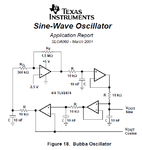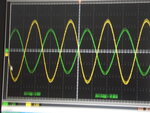unitt
Member level 1

Hi all,
I have running a bubba sinus oscillator on 20Khz. The picture show the input and output singals. The quad opamp is a LME49740. I buffer the sinus wiht 2 voltage followers. The reason for this is that I will get a non-inverting and an inverting sinus.
And here goes it wrong and no idea how to get it.
I have much time spend wiht try-outs. but
every time no result.
Is here anyone who can explain what to do.
thank you.
I have running a bubba sinus oscillator on 20Khz. The picture show the input and output singals. The quad opamp is a LME49740. I buffer the sinus wiht 2 voltage followers. The reason for this is that I will get a non-inverting and an inverting sinus.
And here goes it wrong and no idea how to get it.
I have much time spend wiht try-outs. but
every time no result.
Is here anyone who can explain what to do.
thank you.












